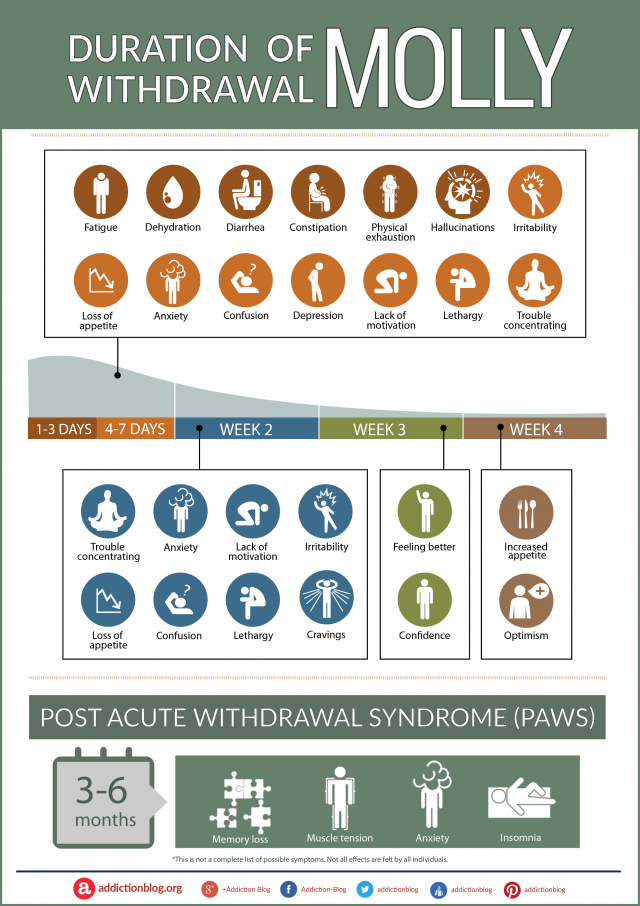Timing for Molly Withdrawal
Molly is a powder/crystalline form of ecstasy (MDMA). While many people think that you cannot develop an addiction to Molly, the truth is that MDMA can be habit forming in some people. Further, regular users can build up tolerance and dependence to MDMA. Still, any dose of Molly causes changes in the brain. So, when you stop taking it, you may experience “withdrawal symptoms”.
But what can you expect during Molly withdrawal? Explore more in our drug withdrawal infographic to learn to identify each symptom and match it with its time of appearance. Finally, if you have further questions, please leave them in the comments section at the end. We try to respond to all real life questions personally.

Molly Withdrawal Timeline
Since Molly is a psychoactive drug, it can cause both physical and psychological dependence. Keep in mind that even though it takes only 2 to 4 days for the body to remove MDMA from the system, the length of Molly withdrawal varies from individual to individual. Further, each dose of MDMA causes unnatural spikes of dopamine to flood the brain. The time it takes for the brain to return to a normal state of homeostasis can result in “withdrawal”…even after first use!
Generally, the severity of Molly withdrawal depends upon several factors, including:
- using MDMA with other substances
- frequency and dosing amount of Molly use
- a person’s general health
- individual body metabolism rate
- age, gender, and size
REMEMBER THIS: Any time you use Molly, the mood that you feel afterward is a kind of withdrawal. Dysphoria usually makes you feel crashed out, and dehydration can be severe. Below is a list of common Molly withdrawal symptoms to make possible detoxification more informed:
0-72 after the last Molly intake:
- constipation
- dehydration
- diarrhea
- fatigue
- physical exhaustion
- hallucinations
Week 1 Molly Withdrawal:
- anxiety
- confusion
- depression
- irritability
- loss of appetite
- lack of motivation
- lethargy
- trouble concentrating
Week 2 Molly Withdrawal:
- anxiety
- cravings
- confusion
- irritability
- loss of appetite
- lack of motivation
- lethargy
- trouble concentrating
Week 3 Molly Withdrawal:
- confidence
- feeling better
Week 4 Molly Withdrawal:
- increased appetite
- optimism
How Long To Withdrawal From Molly?
Usually, the most common Molly withdrawal symptoms are resolved within the first 72 hours after the last intake, which makes this period critical for relapse. Physical symptoms usually resolve within a short period of time, however, the psychological symptoms of Molly withdrawal may need more time to resolve.
Additionally, long-term Molly users may undergo prolonged acute withdrawal symptoms (PAWS) that can include:
- anxiety
- insomnia
- memory loss
- muscle tension
NOTE: If you want to overcome the process of detox safely, the best and safest way is to treat any drug withdrawal under medical supervision. Medical professionals can provide emotional support along with counseling care.
Molly Withdrawal Timeline Questions
Do you need help with Molly withdrawal?
CALL 1-877-804-7989 NOW.
This helpline is available any time of the day and the night, and its FREE.
Plus, it’s highly confidential.
Got any more questions about the duration of Molly withdrawal? Please, post them in the comments section below. We’ll get back to you promptly with a personal note.








Related Posts